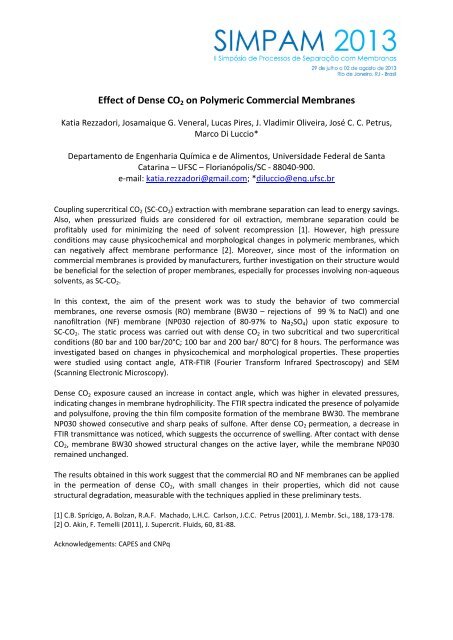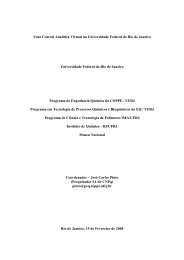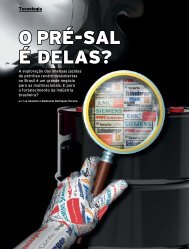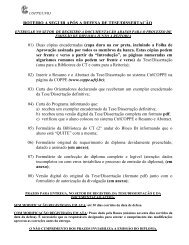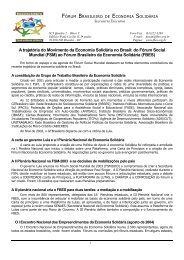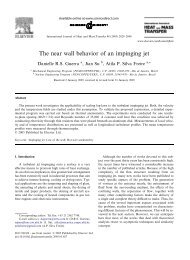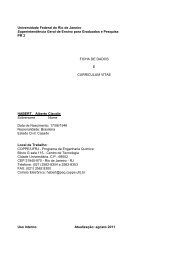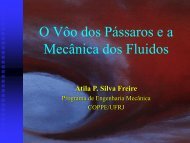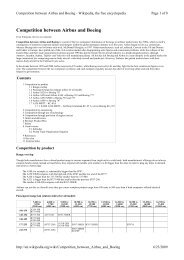Pretreatment Influence on Hexane Permeability in Nanofiltration and ReverseOsmosis Commercial Polymeric MembranesKatia Rezzadori, Frederico M. Penha, Mariane C. Proner, Lara Fogaça, José C. C. Petrus,Marco Di Luccio*Departamento de Engenharia Química e de Alimentos, Universidade Federal de SantaCatarina, UFSC, Florianópolis, SC, 88040-900.e-mail: katia.rezzadori@gmail.com; *diluccio@enq.ufsc.brMembrane technology application in non-aqueous systems is not yet fully established, although itspotential for technological innovations in the food, chemical and pharmaceutical industry isrecognized [1]. The development of this technological alternative is related to the chemical stabilityof the membranes, since the exposition of these to organic solvents can cause physicochemicaland/or morphological changes on the membranes, affecting process performance. Studies indicatethat pre-treatment of polymer membranes, by immersion in organic solvents, can ensure themembrane’s contact with the solvent and modification of the selective surface, providing bettersolvent permeation and increasing the performance of the membrane [2].In this context, the aim of this study was to define a pretreatment for commercial polymericmembranes and to characterize these membranes, before and after the pretreatment, usingdifferent techniques. Two reverse osmosis (RO) membranes (BW30 and ORAK, BW30 e ORAK –rejections of 99,5 e 99 % to NaCl, respectively) and two nanofiltration (NF) membranes (NF270 –rejection of 97 % to MgSO 4 and NP030 rejection of 80-97% to Na 2 SO 4 ) were characterized by contactangle, FTIR (Fourier Transform Infrared Spectroscopy) and SEM (Scanning Electronic Microscopy). Themembrane conditioning was studied using distinct solvents (n-hexane, ethanol, n-propanol, isopropanoland n-butanol) in intervals of 2, 8, 12, and 24 hours. After the pretreatment, the n-hexaneflux was measured on each pressure (0-35 bar), at room temperature. A resistance test on n-hexanewas performed for 8 hours at 15 bar for the NF and 20 bar for the RO membranes.The conditioning with ethanol enabled higher hexane fluxes in the membranes ORAK, NF270 andBW30, while NP030 did not presented increases in permeability after the different conditionings. Theconditioning time has no significant effect (p > 0.05) on the process. Thus, a pretreatment for 2 hourswas chosen for further essays. An increase in the contact angle after the conditioning of themembranes was detected, which reflects changes in hydrophilicity of the surface. The FTIR spectraindicated the presence of polyamide and polysulfone of the membranes ORAK, BW30 and NF270.The membrane NP030 showed consecutive and sharp peaks of sulfone. After hexane permeation, adecrease in FTIR transmittance was noticed, which suggest the occurrence of swelling. SEM analysisdid not show any visible changes in membrane structure, except for the NF270 membrane, whichpresented pore compaction, probably due to applied pressure or to the solvent’s action.The results obtained in this work with commercial membranes of RO and NF, normally used inaqueous solutions separations, indicate that these membranes can be used in separation of nonaqueousmixtures without structural degradation, measurable with the techniques applied in thepreliminary tests.[1] S. Darvishmanesh, J. Degrève, B. Van Der Bruggen (2010), Ind. Eng. Chem. Res., 49, 9330-9338.[2] M.S. Araki, C.M. Coutinho, L.A.G. Gonçalves, L.A Viotto (2010), Sep. Purif. Technol., 71, 13-21.Acknowledgements: CAPES and CNPq
Effect of Dense CO 2 on Polymeric Commercial MembranesKatia Rezzadori, Josamaique G. Veneral, Lucas Pires, J. Vladimir Oliveira, José C. C. Petrus,Marco Di Luccio*Departamento de Engenharia Química e de Alimentos, Universidade Federal de SantaCatarina – UFSC – Florianópolis/SC - 88040-900.e-mail: katia.rezzadori@gmail.com; *diluccio@enq.ufsc.brCoupling supercritical CO 2 (SC-CO 2 ) extraction with membrane separation can lead to energy savings.Also, when pressurized fluids are considered for oil extraction, membrane separation could beprofitably used for minimizing the need of solvent recompression [1]. However, high pressureconditions may cause physicochemical and morphological changes in polymeric membranes, whichcan negatively affect membrane performance [2]. Moreover, since most of the information oncommercial membranes is provided by manufacturers, further investigation on their structure wouldbe beneficial for the selection of proper membranes, especially for processes involving non-aqueoussolvents, as SC-CO 2 .In this context, the aim of the present work was to study the behavior of two commercialmembranes, one reverse osmosis (RO) membrane (BW30 – rejections of 99 % to NaCl) and onenanofiltration (NF) membrane (NP030 rejection of 80-97% to Na 2 SO 4 ) upon static exposure toSC-CO 2 . The static process was carried out with dense CO 2 in two subcritical and two supercriticalconditions (80 bar and 100 bar/20°C; 100 bar and 200 bar/ 80°C) for 8 hours. The performance wasinvestigated based on changes in physicochemical and morphological properties. These propertieswere studied using contact angle, ATR-FTIR (Fourier Transform Infrared Spectroscopy) and SEM(Scanning Electronic Microscopy).Dense CO 2 exposure caused an increase in contact angle, which was higher in elevated pressures,indicating changes in membrane hydrophilicity. The FTIR spectra indicated the presence of polyamideand polysulfone, proving the thin film composite formation of the membrane BW30. The membraneNP030 showed consecutive and sharp peaks of sulfone. After dense CO 2 permeation, a decrease inFTIR transmittance was noticed, which suggests the occurrence of swelling. After contact with denseCO 2 , membrane BW30 showed structural changes on the active layer, while the membrane NP030remained unchanged.The results obtained in this work suggest that the commercial RO and NF membranes can be appliedin the permeation of dense CO 2 , with small changes in their properties, which did not causestructural degradation, measurable with the techniques applied in these preliminary tests.[1] C.B. Sprícigo, A. Bolzan, R.A.F. Machado, L.H.C. Carlson, J.C.C. Petrus (2001), J. Membr. Sci., 188, 173-178.[2] O. Akin, F. Temelli (2011), J. Supercrit. Fluids, 60, 81-88.Acknowledgements: CAPES and CNPq
- Page 1 and 2:
Amirkabir Univ. Tech., IranApplicat
- Page 3 and 4:
PAM/COPPE/UFRJSynthesis and Charact
- Page 7 and 8:
UFSCUFSCUFSCUFSCUFSCUFSCarUFSCarUFS
- Page 9:
Maximizing Hydrocarbon Liquids Reco
- Page 14 and 15:
Synthesis and Gas permeation proper
- Page 17:
Synthesis and characterization of F
- Page 20 and 21:
[1] M. R. Kosseva (2009), Processin
- Page 22 and 23:
Electrodialysis as desalting or pur
- Page 24 and 25:
average permeate BOD 5 and NH 3 con
- Page 26 and 27:
Evolution of Ion-Exchange Membranes
- Page 28 and 29:
References[1] R. Ghalloussi, W. Gar
- Page 30 and 31:
Development of Sulfonated Polysulfo
- Page 32 and 33:
Selectivity of Nanofiltration Membr
- Page 34 and 35:
Clarification of RED Beetroot Juice
- Page 36 and 37:
Definition Of The Limiting Flux Con
- Page 38 and 39:
Evaluation Of Reverse Osmosis And N
- Page 40:
New Polyamide Membranes from PAMAM
- Page 43 and 44:
The output variables in this study
- Page 45 and 46:
In-module chemical modification and
- Page 48 and 49:
Catalytic Microfiltration Membranes
- Page 50 and 51:
Table 1 shows the results of permea
- Page 52 and 53:
Newly Developed Composite Hollow Fi
- Page 54:
Antimicrobial polyvinyl alcohol fil
- Page 59 and 60:
Polycaprolactone membranes by phase
- Page 61 and 62:
[5] A. P. Harvey, M. R. Mackley, an
- Page 63 and 64:
Use of Membrane Contactor to Improv
- Page 65 and 66:
Recovery and concentration of efflu
- Page 67 and 68:
Synthesis and Characterization of M
- Page 69 and 70:
Superficial Characterization and Lo
- Page 71 and 72:
Membrane Adsorber Process for Decon
- Page 74 and 75:
Study of PVC Membranes Prepared Via
- Page 76 and 77:
Polyvinyl Alcohol / Activated Carbo
- Page 78 and 79:
Facilitated Transport of Polypropyl
- Page 80 and 81:
Preparation of Chlorine-Resistant N
- Page 82 and 83:
Direct Osmosis Process for Power Ge
- Page 84 and 85:
Bio-Lubricant Production by Pervapo
- Page 86 and 87:
Application of Ceramic Membranes fo
- Page 89 and 90:
Polyurethane Membranes to Remove Su
- Page 91 and 92:
Mixed Matrix Membranes for Gas Sepa
- Page 93 and 94:
Oily Wastewater Treatment by Membra
- Page 95 and 96:
Concentration of Copper (ppm)Percen
- Page 97 and 98:
sections of membranes were observed
- Page 100 and 101:
CO 2 Separation from Natural Gas wi
- Page 102 and 103:
CO 2 Removal Systems with Membranes
- Page 104 and 105:
[6] V. Alekseev (2010), Mar. Poll.
- Page 107 and 108:
Submitted to SIMPAM 2013www.peq.cop
- Page 109 and 110:
Characterization of the Pore Size o
- Page 111 and 112:
Volume Fraction (φ)Volume Fraction
- Page 113 and 114:
Flux (kg/m 2 .hr) Flux (kg/m 2 .hr)
- Page 115 and 116:
Characterization of ionic liquid an
- Page 117 and 118:
Permeability [Barrer]7x10 46x10 45x
- Page 119 and 120:
Characteristic and Applications of
- Page 121 and 122:
Remoção de Cor (%)Remoção de Tu
- Page 123:
Removal of Trihalometanes Precursor
- Page 127 and 128:
eutilization for domestic purposes.
- Page 129 and 130:
Comparative Analysis of electrodial
- Page 132 and 133:
Intensidade (u.a.)Preparation and c
- Page 134 and 135:
THE PERFORMANCE OF A SYSTEM OF WATE
- Page 137 and 138:
Evaluating the Quality of treated w
- Page 139 and 140:
To determine the permeate flux used
- Page 141 and 142:
ConclusionsAt the present time, bas
- Page 143 and 144:
Analysis of Polymer Membranes Obtai
- Page 145:
Performance and selectivity of LLDP
- Page 148 and 149:
IntensityIntensityFigure 1. Effect
- Page 150 and 151:
Sol-gel Processing of Titania Membr
- Page 152 and 153:
All curves presented linear shape a
- Page 154 and 155:
Figure 2 - Box-Plot - Coefficient o
- Page 156 and 157:
Toxicity removal on leachate treatm
- Page 158 and 159:
Poly(vinyl alcohol) and Chitosan Bl
- Page 160 and 161:
Pressure / TorrPressure / TorrThis
- Page 162 and 163:
Vinasse Treatment by Anaerobic Memb
- Page 164 and 165:
Preparation and characterization of
- Page 166 and 167: Microfiltration for Indigo Blue Dye
- Page 168 and 169: PLGA Nanoparticles Containing Dexam
- Page 170 and 171: As can be seen in Table 1, the syst
- Page 172 and 173: 231Figure 2 - Photograph of the pil
- Page 174 and 175: AcknowledgementsThe authors acknowl
- Page 176 and 177: Table 2 - NF feed and permeate qual
- Page 178 and 179: COD Feed (mg/L)COD Feed (mg/L)COD P
- Page 180 and 181: [4] RESOLUTION Nº 430, OF MAY 13,
- Page 182 and 183: Synthesis and characterization of m
- Page 184 and 185: Ultrafiltration/Nanofiltration for
- Page 186 and 187: Preparation of Electrodialysis Memb
- Page 188 and 189: [4] E. Sgreccia; M.L. Di Vona; P. K
- Page 190 and 191: Table 1. Evaluation of solutions ob
- Page 192 and 193: Concentration of ovine cheese whey
- Page 194 and 195: [11] A. Chollangi; M. Hossain (2007
- Page 196 and 197: Biofilm Formation on Laboratory Nan
- Page 198 and 199: Removal of nitrate in aqueous efflu
- Page 200 and 201: (aFigura 2. Difratograma das alumin
- Page 202 and 203: AcknowledgementsReferencesWe gratef
- Page 204: [1] COTE, P.; BUISSON, H.; PRADERIE
- Page 207 and 208: [1] Larminie, J., Dicks, A. Fuel ce
- Page 209 and 210: Magnetic Field Influence on Cleanin
- Page 211 and 212: Influence Of Pretreatment On The Pe
- Page 213 and 214: [3] Shukla, R., Cheryan, M. (2002)
- Page 215: Separation of Mixtures of Soybean O
- Page 219 and 220: Whey VRF1,5 VRF2 VRF 2,5 VRF 3 VRF
- Page 221 and 222: A Study of the Resistances During P
- Page 223 and 224: Characterization of Cellulose Aceta
- Page 225 and 226: Characterization of Cellulose Aceta
- Page 227 and 228: Monitoring the Shelf Life of Microf
- Page 229 and 230: Clarification of Artichoke By-produ
- Page 231 and 232: WATER TREATMENT TO HEALTH CLINICSAn
- Page 233 and 234: PAPER TITLE: ULTRAFILTRATION AS PRE
- Page 235 and 236: Continuous Production of Biodiesel
- Page 237 and 238: Performance of Liquid Membranes in
- Page 239 and 240: Performance of Batch Pervaporation
- Page 241 and 242: Demineralization of waste waters co
- Page 243 and 244: Electrodialysis for food and enviro
- Page 245 and 246: Optimizing Cobalt (II) Removal from
- Page 247 and 248: The permeability of the material sh
- Page 249 and 250: 1D and 2D Approach for Modelling Ho
- Page 251 and 252: Multi-stage Design for Carbon Captu
- Page 253 and 254: Membrane Fouling Control using High
- Page 255: AcknowledgmentsL.C. Tomé is gratef
- Page 258 and 259: Treatment of Kraft Pulp Mill (EPO)
- Page 260 and 261: Comparison of the Performance of Me
- Page 262 and 263: These novel membranes are potential
- Page 264 and 265: Polycarbonate Modified Membranes Wi
- Page 266 and 267:
Industrial Application of Membranes
- Page 268 and 269:
Production of Filtrating Membranes
- Page 270 and 271:
the high contact area provided by h
- Page 272 and 273:
of the retentate must be closely co
- Page 274 and 275:
Polymeric nanofiltration Membranes
- Page 276 and 277:
Diffusion of Monovalent Cations thr
- Page 278 and 279:
Effect of the UF-Membrane Cut-off o
- Page 280 and 281:
Saxitoxins Removal by NF270 e NF90
- Page 282:
Effect of Plasma Activation on Poly


